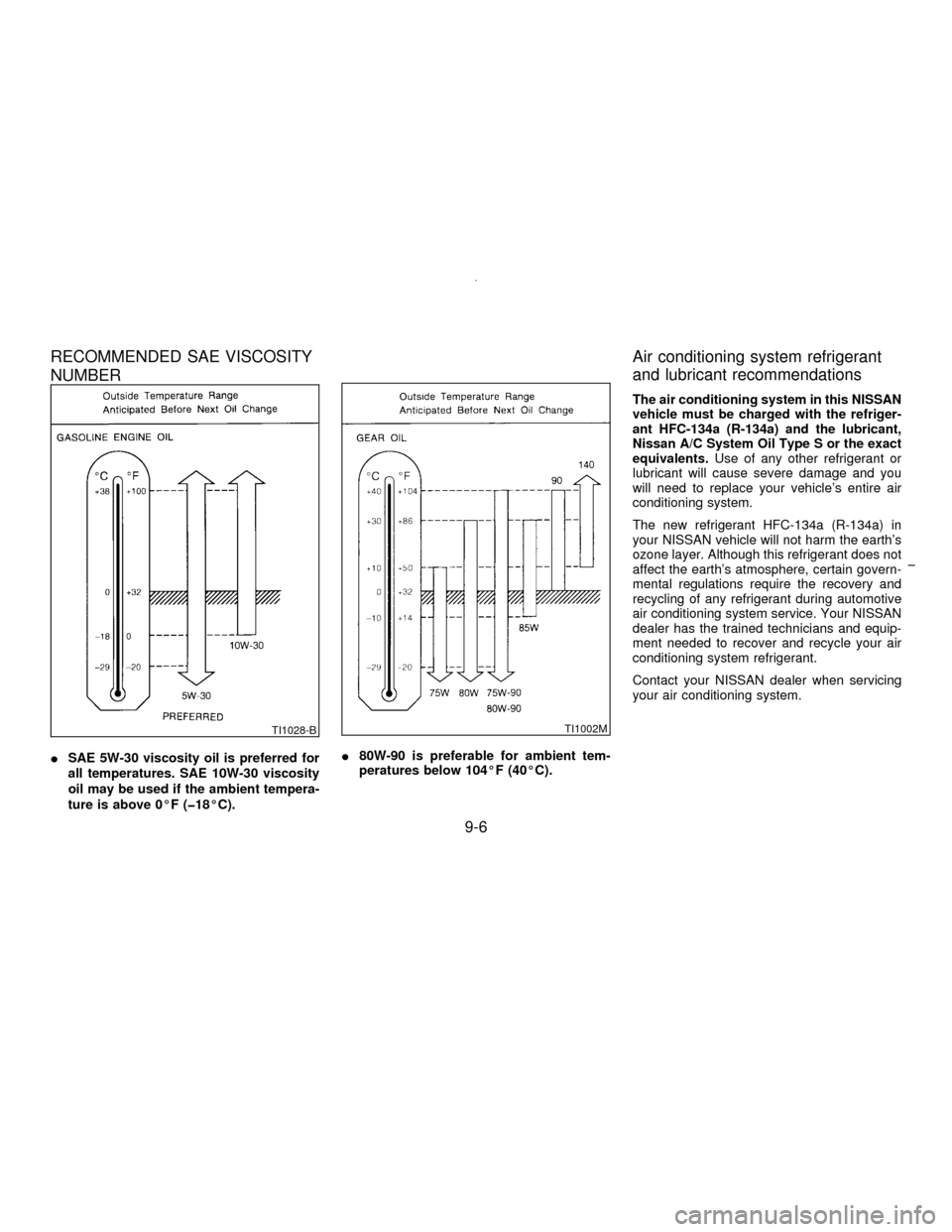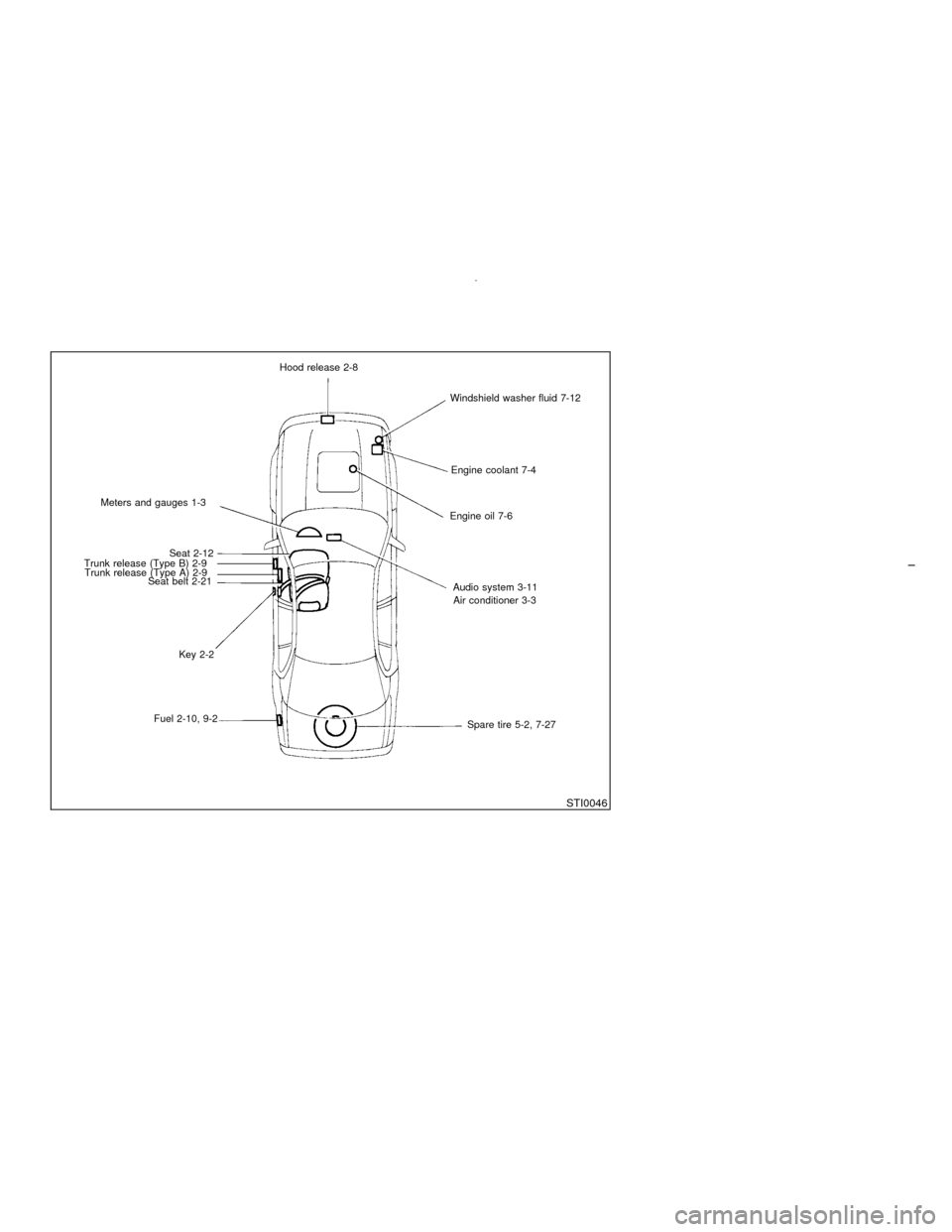1996 NISSAN MAXIMA air condition
[x] Cancel search: air conditionPage 173 of 197

The following are approximate capacities. The actual refill capacities may be a little
different. When refilling, follow the procedure instructed in the ªDo-it-yourself operationsº
section to determine the proper refill capacity.
Capacity (Approximate)
Recommended
specifications US
measureImp
measureLiter
Fuel 18-1/2 gal 15-3/8 gal 70Unleaded gasoline with an octane rating
of at least 91 AKI (RON 96)
Engine oil (Refill)
With oil filter 4-1/4 qt 3-1/2 qt 4.0IAPI SG or SH and Energy Conserving
II*1, *2
IAPI Certification Mark*1, *2 Without oil filter 3-7/8 qt 3-1/4 qt 3.7
Cooling system
With reservoir 9 qt 7-1/2 qt 8.5
Anti-freeze coolant
(Ethylene glycol base)
Reservoir 7/8 qt 3/4 qt 0.8
Manual transmission gear oilÐ Ð Ð API GL-4*3
Automatic transmission fluid
Refill to the proper oil level according
to the instructions in the ªDo-it-
yourself operationsº section.Nissan Matic ªDº (Continental U.S. and
Alaska) or Genuine Nissan Automatic
Transmission Fluid (Canada).*4
Power steering fluid Type DEXRON
TMII or equivalent
Brake and clutch fluidGenuine Nissan Brake Fluid or equiva-
lent*3
DOT 3 (US FMVSS No. 116)
Multi-purpose greaseÐ Ð Ð NLGI No. 2 (Lithium soap base)
Air conditioning system refrigerantÐ Ð Ð HFC-134a (R-134a)
Air conditioning system lubricants Ð Ð ÐNissan A/C System Oil
Type S or exact equivalent
*1: For further details, see ªEngine oil and oil filter recommendationº.
*2: For further details, see ªRecommended SAE viscosity numberº.
*3: For more information regarding suitable fluids, contact a NISSAN dealer.
*4: Dexron III/Mercon
or equivalent may also be used. Outside the continental United States and Alaska contact a NISSAN dealer for
more information regarding suitable fluids, including recommended brand(s) of DexronIII/Merconor DexronIIE/MerconAutomatic Transmission Fluid.
FUEL RECOMMENDATION
Unleaded premium gasoline with an octane
rating of at least 91 AKI (Anti-Knock Index)
number (Research octane number 96)
If unleaded premium gasoline is not avail-
able, unleaded regular gasoline with an
octane rating of at least 87 AKI (Research
octane number 91) can be used.
However, for maximum vehicle perfor-
mance, the use of unleaded premium gaso-
line is recommended.
Using a fuel other than that specified
could adversely affect the emission con-
trol devices and systems, and could
also affect the warranty coverage.
Under no circumstances should a
leaded gasoline be used, since this will
damage the three-way catalyst.
Reformulated Gasoline
Some fuel suppliers are now producing refor-
mulated gasolines. These gasolines are spe-
cially designed to reduce vehicle emissions.
CAPACITIES AND
RECOMMENDED
FUEL/LUBRICANTS
9-2
Z01.2.1/A32-DX
Page 174 of 197

Nissan supports efforts towards cleaner air
and suggests that you use reformulated gaso-
line when available.
Gasoline containing oxygenates
Some fuel suppliers sell gasoline containing
oxygenates such as ethanol, MTBE and
methanol with or without advertising their pres-
ence.
If you use oxygenate-blend gasoline, please
take the following precautions as the usage of
such fuels may cause vehicle performance
problems and/or fuel system damage.
IThe fuel should be unleaded and have
an octane rating no lower than that rec-
ommended for unleaded gasoline.
IIf an oxygenate-blend, excepting a
methanol blend, is used, it should con-
tain no more than 10% oxygenate.
(MTBE may, however, be added up to
15%.)
IIf a methanol blend is used, it should
contain no more than 5% methanol (me-
thyl alcohol, wood alcohol). It should
also contain a suitable amount of appro-
priate cosolvents and corrosion inhibi-
tors. If not properly formulated with ap-
propriate cosolvents and corrosion
inhibitors, such methanol blends maycause fuel system damage and/or ve-
hicle performance problems. At this
time, sufficient data is not available to
ensure that all methanol blends are suit-
able for use in Nissan vehicles.
If any undesirable driveability problems such
as engine stalling and hard hot starting are
experienced after using oxygenate-blend fu-
els, immediately change to a non-oxygenate
fuel or a fuel with a low blend of MTBE.
Take care not to spill gasoline during refu-
eling. Gasoline containing oxygenates can
cause paint damage.
Aftermarket fuel additives
Nissan does not recommend the use of any
fuel additives (i.e. fuel injector cleaner, octane
booster, intake valve deposit removers, etc.)
which are sold commercially. Many of these
additives intended for gum, varnish or deposit
removal may contain active solvent or similar
ingredients that can be harmful to the fuel
system and engine.
Octane rating tips
In most parts of North America, you should use
unleaded gasoline with an octane rating of at
least 87 or 91 AKI (Anti-Knock Index) number.
However, you may use unleaded gasoline with
an octane rating as low as 85 AKI (Anti-KnockIndex) number in these high altitude areas
[over 4,000 ft (1,219 m)] such as: Colorado,
Montana, New Mexico, Utah, Wyoming, north-
eastern Nevada, southern Idaho, western
South Dakota, western Nebraska, and that
part of Texas which is directly south of New
Mexico.
Using unleaded gasoline with an octane
rating lower than stated above can cause
persistent, heavy ªspark knockº. (ªSpark
knockº is a metallic rapping noise.) If se-
vere, this can lead to engine damage. If you
detect a persistent heavy spark knock even
when using gasoline of the stated octane
rating, or if you hear steady spark knock
while holding a steady speed on level
roads, have your dealer correct the condi-
tion. Failure to correct the condition is
misuse of the vehicle, for which NISSAN is
not responsible.
Incorrect ignition timing will result in knocking,
after-run or overheating. This in turn may
cause excessive fuel consumption or damage
to the engine. If any of the above symptoms
are encountered, have your vehicle checked at
a NISSAN dealer or other competent service
facility.
However, now and then you may notice
light spark knock for a short time while
9-3
Z01.2.1/A32-DX
Page 177 of 197

RECOMMENDED SAE VISCOSITY
NUMBER
ISAE 5W-30 viscosity oil is preferred for
all temperatures. SAE 10W-30 viscosity
oil may be used if the ambient tempera-
ture is above 0ÉF (þ18ÉC).I80W-90 is preferable for ambient tem-
peratures below 104ÉF (40ÉC).
Air conditioning system refrigerant
and lubricant recommendations
The air conditioning system in this NISSAN
vehicle must be charged with the refriger-
ant HFC-134a (R-134a) and the lubricant,
Nissan A/C System Oil Type S or the exact
equivalents.Use of any other refrigerant or
lubricant will cause severe damage and you
will need to replace your vehicle's entire air
conditioning system.
The new refrigerant HFC-134a (R-134a) in
your NISSAN vehicle will not harm the earth's
ozone layer. Although this refrigerant does not
affect the earth's atmosphere, certain govern-
mental regulations require the recovery and
recycling of any refrigerant during automotive
air conditioning system service. Your NISSAN
dealer has the trained technicians and equip-
ment needed to recover and recycle your air
conditioning system refrigerant.
Contact your NISSAN dealer when servicing
your air conditioning system.
TI1028-BTI1002M
9-6
Z01.2.1/A32-DX
Page 182 of 197

TIRE PLACARD
The cold tire pressure is shown on the tire
placard affixed to the center console lid.
AIR CONDITIONER
SPECIFICATION LABEL
The label is affixed inside of the hood as
shown.
Use the following steps to mount the license
plate:
1. Make a hole in each plastic finisher (There
are small marks on the bumper) using a
0.31 in (8 mm) drill. To avoid damaging the
STI0043STI0044
STI0045
INSTALLING LICENSE PLATE
9-11
Z01.2.1/A32-DX
Page 187 of 197

the transmission to a lower gear and reduce
speed to reduce chances of engine over-
loading and/or overheating.
IIf the engine coolant rises to an extremely
high temperature when the air conditioning
system is on, turn off the air conditioner.
Coolant heat can be additionally vented by
opening the windows, switching the fan
control to high and setting the temperature
control to the ªHOTº position.
ITrailer towing requires more fuel than nor-
mal circumstances.
IAvoid towing a trailer for the first 500 miles
(800 km).
IHave your vehicle serviced more often than
at intervals specified in the recommended
Maintenance Schedule.
IWhen making a turn, your trailer wheels will
be closer to the inside of the turn than your
vehicle wheels. To compensate for this,
make a larger than normal turning radius
during the turn.
ICrosswinds and rough roads will adversely
affect vehicle/trailer handling, possibly
causing vehicle sway. When being passed
by larger vehicles, be prepared for possible
changes in crosswinds that could affect
vehicle handling. If swaying does occur,firmly grip the steering wheel, steer straight
ahead, and immediately (but gradually) re-
duce vehicle speed. This combination will
help stabilize the vehicle. Never increase
speed.
IBe careful when passing other vehicles.
Passing while towing a trailer requires con-
siderably more distance than normal pass-
ing. Remember the length of the trailer
must also pass the other vehicle before you
can safely change lanes.
ITo maintain engine braking efficiency and
electrical charging performance, do not use
fifth gear (manual transmission) or over-
drive (automatic transmission).
IAvoid holding the brake pedal down too
long or too frequently. This could cause the
brakes to overheat, resulting in reduced
braking efficiency.
When towing a trailer, change oil in the
transmission more frequently.
See the Maintenance schedule.
9-16
Z01.2.1/A32-DX
Page 192 of 197

10 Index
A
Air bag warning light ....................................... 2-21
Air cleaner filter ............................................... 7-16
Air conditioner
Air conditioner operation ............................. 3-5
Air conditioner specification label.............. 9-11
Automatic air conditioner............................. 3-9
Air flow chart ..................................................... 3-6
AM-FM radio with cassette player .................. 3-12
AM-FM radio with cassette player and compact
disc player (Bose audio system) .................... 3-16
Antenna........................................................... 3-22
Anti-lock brake system ................................... 4-17
Automatic
Automatic air conditioner............................. 3-9
Automatic transmission fluid ....................... 7-9
Driving with automatic transmission............ 4-6
Avoiding collision and rollover .......................... 4-3
B
Battery............................................................. 7-12
Battery replacement.......................................... 2-7
Before starting the engine ................................ 4-6
Brake
Anti-lock brake system .............................. 4-17
Brake and clutch fluid................................ 7-11
Brake booster ............................................ 7-20Brake pedal ............................................... 7-19
Brake wear indicators ........................ 1-8, 7-19
Parking brake ................................... 4-11, 7-18
Break-in schedule ........................................... 4-13
C
Capacities and recommended fuel/lubricants... 9-2
Caution and warning labels ............................ 2-21
CB radio or car phone .................................... 3-23
Changing
Changing engine coolant ............................ 7-5
Changing engine oil .................................... 7-7
Changing oil filter ........................................ 7-8
Checking engine coolant level .......................... 7-4
Checking engine oil level .................................. 7-6
Child restraints for infants and small children .... 2-
29
Child safety ..................................................... 2-23
Child safety rear door lock................................ 2-3
Cigarette lighter and ash trays ....................... 1-17
Cleaning exterior and interior ........................... 6-2
Clock ............................................................... 1-21
Clutch pedal .................................................... 7-20
Cold weather driving cautions ........................ 4-18
Compact disc (CD) player operation .............. 3-21
Controls............................................................. 3-3
Coolant
Changing engine coolant ............................ 7-5
Checking engine coolant level .................... 7-4Engine coolant temperature gauge ............. 1-4
Cornering light ................................................ 1-14
Corrosion protection ......................................... 6-5
Cruise control.................................................. 4-12
Cup and card holders ..................................... 1-18
DDefogger switch
Rear window and outside mirror defogger
switch......................................................... 1-12
Dimensions and weights ................................... 9-8
Door lock operation .......................................... 2-6
Door locks ......................................................... 2-2
Door unlock operation ...................................... 2-6
Drinking alcohol/drugs and driving ................... 4-4
Drive belts ....................................................... 7-13
Driving
Cold weather driving cautions ................... 4-18
Drinking alcohol/drugs and driving .............. 4-4
Driving with automatic transmission............ 4-6
Driving with manual transmission ............... 4-9
Precautions when driving .......................... 4-16
Precautions when starting and driving ........ 4-2
E
Economy hints ................................................ 4-14
Emission control information label .................. 9-10
Emission control system warranty .................. 9-18
Z01.2.1/A32-DX
Page 197 of 197

Hood release 2-8
Meters and gauges 1-3
Seat 2-12
Trunk release (Type B) 2-9
Trunk release (Type A) 2-9
Seat belt 2-21
Key 2-2
Fuel 2-10, 9-2
Spare tire 5-2, 7-27 Air conditioner 3-3 Audio system 3-11 Engine oil 7-6Engine coolant 7-4 Windshield washer fluid 7-12
STI0046
Z01.2.1/A32-DX